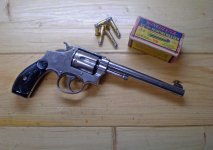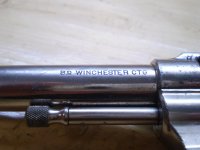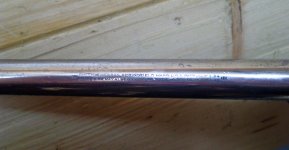FYI:
SERIAL # LOCATIONS: To confirm all parts are original, one can check for the 6 (or 7 - Triple Lock models only) matching serial # locations for fixed sight pre war Hand Ejectors and all post war Hand Ejectors thru ~1956 and a few as much as 3 years later.
NOTE: Observing serial #s with accuracy or even existence, especially on penciled stocks, requires magnification, bright light, and an attitude that they are there!
1. Grip frame butt (prefixed by a letter(s) following WWII) - or fore strap on I frame Regulation Police models and single shots with grips that cover the butt
2. Barrel - bottom of barrel or in extractor shroud, (Triple locks have tiny #s stamped in front end of the shroud; sideways/vertical if over 3 numerical digits, otherwise horizontal).
3. Yoke - on rear face only visible thru a chamber with a flashlight (except the .32 Model 1896 and no doubt a few others)
4. Extractor star – backside (which is actually the side facing the muzzle).
5. Cylinder - rear face
6. Right stock only - on back, scratched or penciled depending on vintage and stock material, stamped after 1929, (except most post war target grips because individual fitting not required.)
7. .44 TL models only: rear side of middle lock cam plate (Triple Lock models only)
Pre war serial #s on the butt read with barrel to the right and are centered, or offset if produced with a lanyard swivel (factory installed swivels are drilled with a jig and always 1/10” forward of center). Post war #s read with barrel to the left and are all offset to the rear.
ASSEMBLY (factory work, soft fitting) #s: These multi-digit numbers of 3 to 5 digits, are on the yoke at the hinge, in the ‘yoke cut’ of the frame opposite the yoke near the hinge (usually accompanied with the inspector’s letter or # code stamp of approval, but not always), and inside of the sideplate, for the pre war and early post war period thru ~early 1958. Once the gun is shipped, the only use for the assembly # is to confirm the three parts it's stamped on, are original to the gun. These are still in use to this day.
After the 6/22/1957 change order, Model #s were assigned and eventually stamped on the frame in the yoke cut. The serial # was soon after added in the ‘yoke cut’ as well and the assembly # moved from there to the left side of the grip frame parallel to the butt. More currently beginning in the 1980’s we see non-matching multi-digit numbers parallel to the butt left or right side, and inside the side plate.



